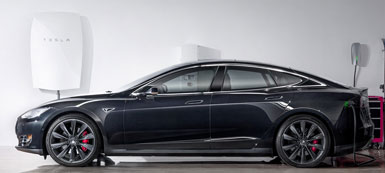On May 1, Elon Musk announced the launch of Tesla Energy – a day we may look back on years from now as when the renewable energy revolution really took off.
This quote tells us why this is such a watershed development:
"I think in the near future, having a battery in your home will be as normal as having a water heater or a dishwasher. This takes us one step closer to being able to power homes completely without the use of fossil fuels," says Jason Ballard, President of TreeHouse, a green home improvement store that sells Powerwall.
"Powerwall Home Battery" is a lithium battery that inconspicuously hangs on a garage (or outdoor) wall. Tesla has succeeded in designing a battery that’s powerful yet small and affordable.
"You can order it now," Musk says, "it comes in different colors."
It can take a house with rooftop solar off the grid or be used as a backup during power outages, and of course charge electric cars.
The price for installers is $3000-$3,500, depending on the amount of energy it stores. Homeowners have to pay for an inverter and installation costs, but the price is still far below what analysts anticipated – around $13,000.
Right now the batteries are made at Tesla’s California auto plant, but Musk has promised prices will drop 30% in the first year the Nevada Gigafactory comes online. And that’s just the beginning.
Notice Powerwall hanging on the wall next to Tesla’s car:

For businesses and utilities, Tesla Energy offers "Powerpacks," more powerful versions of the home-based system "designed to scale infinitely." They integrate lithium batteries, power electronics, thermal management and controls into a turnkey system.
Powerpacks are being piloted in over 100 projects, including Amazon Web Services data centers, Target and Walmart stores and Green Mountain, Southern California Edison and other utilities.
Incredibly, Musk plans to make its battery patents available for free as he has done for the electric car.
"The goal is complete transformation of the entire energy infrastructure of the world," Musk says, and we would expect nothing less from him!
Utilities Beware
Utilities that insist on holding onto the past could find 50% of residential sales and 60% of commercial sales gone in the US Northeast by 2030, says the Rocky Mountain Institute.
In the next 10-15 years, solar-plus energy storage will cost less in states where utility-supplied electricity is expensive, which includes California and Hawaii.
That would leave utilities high and dry without the money to maintain and upgrade the grid so clearly new business models for utilities are needed.
Revenue from energy storage enabling technologies is expected to grow from $605 million a year now to over $21 billion by 2024 worldwide, according to Navigant Research.
How About Nuclear?
The nuclear industry’s big talking point is its reliable base load power, but with the ability to store solar and wind energy that’s no longer an advantage. There’s no comparison on the costs – or the time – to build renewable energy projects, the largest of which take a couple of years. And wouldn’t it be great not to have to worry about nuclear waste or a meltdown?
Speaking about nuclear company Exelon’s mission to extract $1.6 billion from Illinois taxpayers to subsidize nuclear plants that are losing money, Dave Kraft, director of Nuclear Energy Information Service says:
"If legislators are worried about job loss from Exelon’s reactor closures, perhaps instead of giving Exelon a $1.6 billion bailout for nuclear reactors that currently can’t compete with wind power without battery storage, the legislature should give it to Elon Musk to build a Powerwall production facility in Illinois."
Legislators "must choose which century the Illinois economy and energy systems will end up in – the 19th with Exelon’s anachronistic "big-box utility" business model, or the 21st with Tesla and all the rest that goes with it. Legislators can no longer hide behind the nuclear boogeymen arguments that they have to give Exelon ‘something,’ or we’ll all freeze in the dark when the wind doesn’t blow, and jobs will be lost. There are plenty of good, high-paying jobs ahead – if the Legislature chooses the future over the past – and the lights WILL MOST CERTAINLY stay on," Kraft observes.
Read our article, Energy Storage: The Next Big Innovative Technology.

Thanks so much; this will help us with our decision to go forth with solar. You Tesla et al. guys are amazing!
We have all the features of the PV and storage and you don’t need the TESLA batteries to make it viable for your home. Our system includes the energy management and storage optimization using the innovative Transverter bi directional power control system. Contact me for more info at dkatz@sustainable-es.com